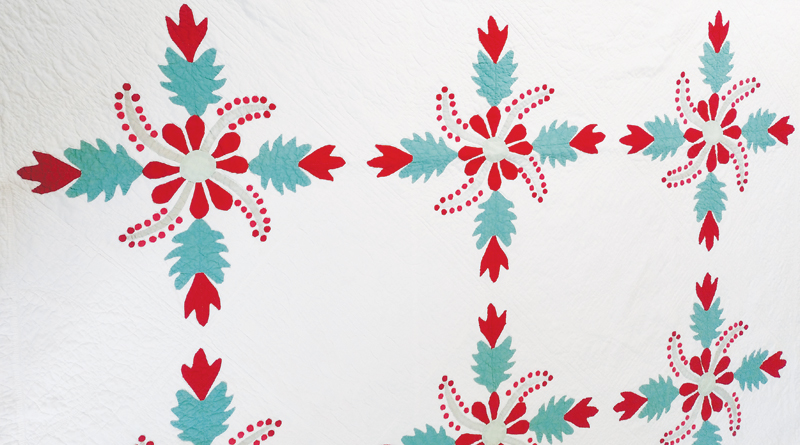Centuries Old Grapes & Oak Leaf Quilt Acquired By FWMoA ~ Around The Frame
When former lake neighbor Susan asked me to sell the family quilts belonging to her East Coast aunt, I never dreamed what I would discover. Looking through the quilts with her down at Born Again Quilts, it was evident that some were worn, or had an issue with a particular fabric that didn’t withstand the test of time. One red and green quilt, however, stood out amongst the rest. The applique work, the lavish hand quilting, it’s stellar condition: this one indeed was a family treasure. I advised Susan that I understood that she couldn’t keep them all, but I highly recommended she keep this one. Being the mother of three daughters, it would be something they could touch and connect themselves to family members who have long ago passed. Susan acknowledged where I was coming from but having gone through the experience of downsizing her aunt’s property, she and her husband felt they wouldn’t want to burden their daughters with their possessions.

I took the quilt into my custody and set about to learn if the pattern had a name. Using Barbara Brackman’s Encyclopedia of Applique Quilt Patterns, I found it: A circular design with a small circle in the center, eight pieces of two alternating designs: It perfectly matched the description of Grapes and Oak leaf attributed to Roan and Goschenhoppen. The next step was to discover more about “Roan and Goschenhoppen”. I learned Roan refers to Nancy and the late Donald Roan, and Goschenhoppen to a region of Southeastern Pennsylvania.
My computer research took me to the The Goschenhoppen Historians, Inc. that was organized to “identify, preserve, and disseminate the Pennsylvania German (Pennsylvania Dutch) folk culture and history of the Goschenhoppen region.” For over 50 years they have held The Folk Festival, an annual festival as an educational family event to demonstrate various home skills and trades of the Goschenhoppen area from about 1750-1880.
I contacted The Goschenhoppen Historians and spoke to Jodie Ritto, to learn about the Roans. She wrote me that Donald “Abe” and Nancy Roan were early and long-time members of the Historians, and did extensive research about Pennsylvania German food culture, folk culture, and textiles. Textiles include quilts, coverlets, show towels, bed linens, and clothing. Abe and Nancy spearheaded a quilt roundup in the 1990’s. A quilt roundup is when a call goes out to have people bring in their quilts and their stories so they can be documented and preserved. The Roundup was accomplished with the help of many churches, historical societies, and many volunteers who documented over 1,500 quilts and textiles. An exhibit of over 200 of the quilts showcased the strong regional preferences of patterns and designs of the area. The oral histories given by their makers and/or descendants enriched the attendees’ experience.
When I recently did a presentation for the Midwest Fabric Study Group, I included photos of this quilt, and one of the members was not only familiar with the Roans and Goschenhoppen, but she also shared the book title “Lest I Shall be Forgotten” Anecdotes, and Traditions of Quilts, written by Nancy and Donald Roan and copyrighted in 1993 by The Goschenhoppen Historians, Inc. I purchased the book and find it insightful into the Goschenhoppen Region quilting traditions as it features many quilts from the Roundup. The anecdotes and traditions show a glimpse into the lives of Pennsylvania Dutch women. Granny Mumbauer said, “Do not sew on Ascension Day for every stitch you put in this day you have to pull out with your nose when you get to heaven.” Interview with Ruth Seasholtz, Towamencin Township, October 1992.
The book also discusses the absence of quilt design names. Many didn’t have one and they were just called literally what they looked like: hence Susan’s aunt’s quilt was called Grapes and Oak Leaf. It is interesting that “leaf” not “leaves” was used. This quilt is 80” x 72” on-point blocks with feather wreaths in the alternating blocks and corners. The borders have long feather quilting, the green 3/8” wide binding is slightly scalloped, and hand sewn to the back side. The back was created using 33” wide muslin and sewn by machine with tiny stitches. Solid green and reds were used. The three stuffed grapes at the end of each bunch are a darker color of red than the other. This is not a fluke as all four bunches were created in this manner. The hand piecing and applique work show a master quilter who was not a minimalist created it.
Contacting Susan about what I had discovered, I was interested to know if her aunt’s family had any connection to Pennsylvania. Susan has a personal interest in all things German as she holds a Ph.D.in it and teaches it at the university level: hopefully she’ll get back to me. From what I’ve learned, I’d estimate it was made between 1855 – 1875.
This quilt deserved a home where it can be viewed and appreciated for its beauty and workmanship. That home is now the Fort Wayne Museum of Art where the staff was ecstatic to acquire it for its quilt collection. If you are interested in poking around the Goschenhoppen quilt collection, go to: https://goschenhoppen.org/textile-collection-online-catalog/
Wishing you all a warm and happy holiday season!
- Fabric Designs Across Time: Around The Frame - January 16, 2026
- St. Lucia & Swedish Quilts: Around The Frame - December 5, 2025
- FWMoA To Exhibit Amish & Contemporary Quilts: Around The Frame - November 7, 2025


